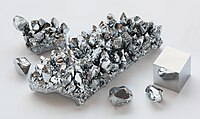
Photo from wikipedia
INTRODUCTION This study was performed to evaluate the oxidative and histopathological changes that occur following the application of electrosurgical devices (monopolar or bipolar cautery) to penile tissue. MATERIAL AND METHODS… Click to show full abstract
INTRODUCTION This study was performed to evaluate the oxidative and histopathological changes that occur following the application of electrosurgical devices (monopolar or bipolar cautery) to penile tissue. MATERIAL AND METHODS Eighteen Wistar albino male rats were randomly distributed into three groups. In the control group (CG, n = 6), all penile tissues were sampled without any additional process following the administration of anesthesia. In the monopolar cautery group (MPG, n = 6), a 15-W cauterization process lasting 5 s was performed on an approximately 2 mm2 area of the ventral side of the penile shaft, 0.5 cm proximal to the edge of the glans in the midline. Bipolar cautery was practiced in the third group (BPG, n = 6) using the same techniques outlined in the previous statement. Penile tissues consisted of the cautery application area, the edge of the glans, and dorsal side of the penis and were sampled after 90 min; then, histopathological evaluation and biochemical examination involving malondialdehyde (MDA), nitric oxide (NO), and superoxide dismutase (SOD) measurements were performed. RESULTS AND DISCUSSION Histopathologically, the MPG and BPG demonstrated increased inflammation, fibrosis, and epithelial loss in the urethra in the areas to which cautery was applied as compared to the CG (P < 0.05). The vascular structures of the corpus cavernosa were significantly decreased in the cautery application area of both the MPG and the BPG as compared to the CG (P < 0.05). In the Masson's trichrome stained samples, significant collagen deposition was observed in the cautery application area both in the MPG and the BPG as compared to the CG (P < 0.05). However, S-100 staining was decreased in these groups as compared to the CG (P < 0.05). S-100 staining was also decreased in the MPG as compared to the BPG on the edge of the glans (P < 0.05). Biochemically, MDA values were significantly increased in the MPG as compared to the CG and the BPG (P < 0.05). CONCLUSION Monopolar and bipolar cautery both did cause oxidative changes and triggered inflammatory, vascular, and peripheral nerve alterations in the cautery application area while bipolar cautery did not cause any distant effects.
Journal Title: Journal of pediatric urology
Year Published: 2019
Link to full text (if available)
Share on Social Media: Sign Up to like & get
recommendations!